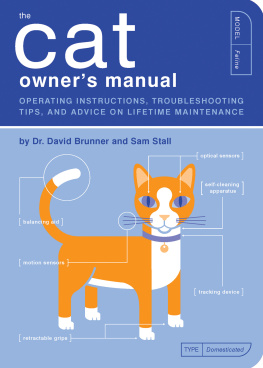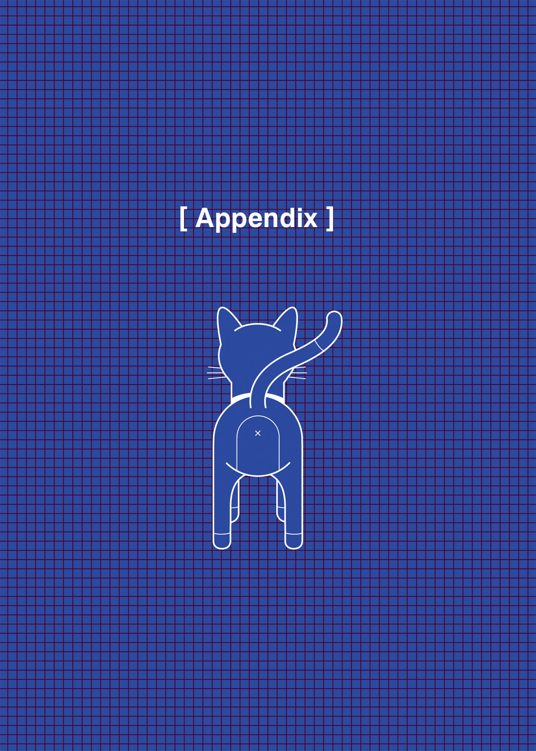For easy access, this section contains answers to frequently asked questions about common feline behavior issues, malfunctions, and quirks. When problems arise with your model, this should be the first place you look.
| MALFUNCTION | CAUSE AND SOLUTION |
| Cat gets stuck in trees. | A trick of physiology makes it very easy for cats to climb trees but difficult for them to climb down. During ascent the feline uses its powerful hindquarters and inward-curving claws to gain altitude. But during descent it must rely on its weaker forelimbs, and its claws point in the wrong direction to be of use. However, it is unnecessary to call the fire department if your feline climbs a tree. Its finely tuned sense of balance will save it from falling. In time it will escape on its ownoften by backing down rump first. |
| Cat kills mice and/or birds, then brings them home to you. | Cats dont recognize pack structures, but they may regard an owner as family. As such, they may choose to honor you by having you share in a kill. The best approach is to not make a scene. Simply dispose of the carcass and then refrain from allowing your cat to roam outdoors unescorted. |
| Cat seems to make a point of pestering visitors who fear or dislike felines, yet ignores guests who love cats. | People who like cats tend to stare at them. Unfortunately, an unflinching stare is considered an aggressive challenge in the feline world. Thus, cats may shy away from people who pay them too much attention. Conversely, they may gravitate toward those who dont make eye contacteven if they avoid doing so because they cannot stand the sight of cats. |
| Cat seems to loathe your new human love interest. | Having a cat disapprove of your new boyfriend/girlfriend is not uncommon. Neither is having it register its dissatisfaction in very unsubtle ways (snarling, perhaps even urinating on his/her possessions). However, the feline can be won over. Place one of the newcomers unwashed pieces of clothing near the cats food bowl, so the feline can familiarize itself with the new scent. Or wear an article of the love interests clothing while you hold the cat. Have the person in question feed the cat or play with it in a nonthreatening way. All of these techniques can create a bond of friendshipor at the very least, tolerance. |
| Cat climbs drapes. | Try securing the drapes with tension rods, which will fall on the cat if it attempts to climb. Once the cat discovers this, it will in most cases discontinue the behavior. |
| Cat chews electrical cords. | For obvious reasons, this behavior must be stopped immediately. Coat the cord with a disagreeable substance, such as Tabasco sauce, orange or lemon peel, or Bitter Apple (a commercial animal repellant). If the problem persists, enclose the cord in a heavy casing (available at electronics stores). |
| Cat hides its food. | When they finish eating, some felines camouflage their food bowls by covering them with a piece of cloth, paper, or some other item. This is probably a bit of leftover programming from the cats wild ancestors, who concealed half-eaten kills so they could return to them later. |
| Cat meows, moans, howls, and makes other sounds constantly, seemingly for no particular reason. | Cats may engage in hypervocalization for a number of reasons. Some breeds, such as the Siamese, are hardwired to make a tremendous racket. In such cases, the phenomenon simply must be accepted. However, formerly quiet cats who suddenly mount sonic assaults on their owners could be suffering from any of a number of software or hardware glitches. An unspayed female will call for mates when in season, and an unneutered male may cry out in response. Other causes range from brain tumors to cognitive dysfunction to physical pain. However, in most cases, the cat is probably doing it for attention. Consult your veterinarian if the problem persists. |
| Cat prefers to drink running rather than standing water and makes a habit of lapping at running or leaking faucets. | Felines may be genetically programmed to prefer running over standing water, which they might perceive as fresher. However, this behavior is by no means universal. Many cats will accept standing water. |
| Cat chews or sucks on wool and other fabrics. | This curious, relatively common feline behavior may be caused by anything from genetic predisposition (Siamese seem particularly prone to it) to boredom. Felines may be attracted to wool garments (and, to a lesser degree, other fabrics) because they smell and feel like prey. If the cat ingests pieces of the garment, or if the behavior is disruptive, the best approach is to simply deny the materials to your feline. |
| Cat meows, but no sound comes out. | This phenomenon is called a silent meow. However, it is silent only to humans. The feline is indeed vocalizing, but at an auditory frequency too high for you to hear. |
| Cat scoots its hindquarters on the floor. | The cats anal glands may be full or impacted and may need to be manually emptied. This simple procedure can be performed at your veterinarians office. If you ignore this behavior, the impacted anal glands can rupture. |
| Cat seems to hate your taste in music. | While some felines show no interest in music, others may react in strong, negative ways to certain performers and/or genres. For instance, cats who loathe sudden, loud noises tend to dislike rock music. Also, many cats are irritated by high notes, which resemble the distress cries of kittens. If your cat seems to become agitated when you play a favorite CD, turn it offor at least turn it down. |
| Cat obsessively bites its nails. | In many cases, this behavior is directly analogous to the human habit of nervous nail-biting. Check for stress factors in the felines environment and try to lessen or eliminate them. This may solve the problem. |
| Cat sleeps in an inappropriate spot, such as a bathroom sink, kitchen cabinet, or clothes hamper. | First, make the spot inaccessible or undesirable by securing it in some way. Next, make sure to offer another attractive location for the cat to rest. Position a comfortable bed there and perhaps use treats and/or catnip as an initial enticement. |
| Cat digs up and/or defecates in potted plants. | Try covering the soil surface of the plant pot with aluminum foil, then surround the pot itself with sheets of foil (cats dislike the texture). Never use mothballs (which repel cats) as a deterrent. The active ingredient, naphthalene, is toxic to felines. |
| Cat actively solicits petting, then hisses, scratches, and/or runs away after only a few seconds of contact. | This behavior is possibly caused by the cats conflicted views on interfacing with humans. On the one hand, being petted is pleasant. On the other, it is a highly unnatural behavior that the adult cats programming rebels against. In some felines this quandary manifests itself by first inviting contact, then emphatically rejecting it. The best approach is to pet the cat when it seems amenable, then break off contact at the first sign of a mood change. |
| Cat eats grass. | The cat may extract nutrients from the greens, or it may eat them to aid digestion. Whatever the reason, moderate grass consumption is natural and not dangerouswith two caveats. Do not allow an indoor cat to chew on houseplants (many are toxic), and do not allow a feline to dine on lawns that were recently chemically treated. |






